Article updated: My Personal P2P Filters for 2015
The ability to filter the available loans at Lending Club and Prosper for those with better historical performance remains one of the few “hacks” available to investors, and when I say hack, I mean investing in a way that is creative and unconventional.
Filtering is not conventional. Most investors probably don’t do it. And you do not see filtering encouraged at Lending Club or Prosper’s websites. While they certainly allow it, no section of either website really promotes the increased return that filtering offers investors who take the time to learn its ropes.
And I actually think that’s a good move on their part. For beginners, even complicating this investment a small degree, particularly by introducing filtering, would probably stop many people from getting on board. If Lending Club or Prosper want the investing side of their websites to become more popular, they have to make investing on them as simple as possible, and for most investors this means avoiding filtering altogether.
That said, there is a wide spectrum of results within this population of investors:
As you can see in the graphic above, investors who select the exact same interest rates (see the arrow) are having different results. In this case, most investors in loans with interest rates between 12-15% (B and C-grades) are earning a 7% return, which is pretty remarkable on its own. However, the top percentile are earning a full percent higher than the rest: around 8% per year, while the bottom percentile are earning just 6%. And both groups are generally taking on a similar degree of risk.
A 2% bump can mean an incredibly higher yield.
Given enough time, a 2% bump can actually mean an incredibly higher yield. Take $10,000 and put it to work at both 6% and 8%. In 30 years your 6% account would have $57,000, while the 8% account would have $100,000. This is a huge difference.
So the question is, how do we become the top investors for our average interest rate? For those investing in safer A-grade notes, how do you earn a 6% ROI (top percentile) instead of a 4% ROI (bottom percentile)? For those investing in riskier E-grade notes, how do you earn a 10% ROI (top percentile) instead of a 7% ROI (bottom percentile)?
In 2014, Filtering Loans Still Earns Higher Returns
The difference is leaning into the higher interest rates of your bracket, and then filtering for loans with higher historical performance. By sifting the hundreds of loans available on these platforms for those that gave higher past returns, we set ourselves up to invest in a cross section of borrowers who are more likely than average to pay their debt back. We then likely experience lower defaults per year, and by extension we earn a higher return.
There has been some discussion about whether or not filtering really matters anymore. Investors like myself have often wondered if the platforms have finally improved their interest rate assignments enough that filtering no longer works. However, a quick look at the data shows this is still not the case, even today.
Below is all of the B3-grade loans issued in 2014 at Lending Club, broken down by borrowers with different credit inquiries (courtesy of NSR):
The exact investment – a very different result! 2014-issued B3-grade loans to borrowers with no credit inquiries are performing a full point better than the rest. If filtering did not matter, these two groups of 11.72%-rated loans would perform the same. But they don’t. Filtering still works, and peer to peer lenders looking to increase their returns would be wise to take advantage of this reality.
My Personal Filters at Lending Club and Prosper
To encourage people to do this, I’m going to share the filter criteria I personally use at Lending Club and Prosper. These filters are probably not ideal for many investors considering they (1) are in riskier loan grades than most take on, and (2) may require an API tool to acquire because they are so rare. That said, they are a decent place for most investors to begin, as we’ll cover at the end of this article.
The usual caveat: These filters are not guaranteed to perform similarly in the future. In fact, they may perform worse than average if the economy deteriorates.
My Lending Club filter (higher risk loans)
Lending Club grades: E, F, & G
Goal: 10-11% ROI
See this filter on NSR
Filter criteria:
- Inquiries: 0
- Annual income: $85,000 or more
- States: Exclude AZ, CA, FL, & NV
- Loan purpose: Exclude ‘business loans’
My Lending Club filter is quite simple with few surprises. At the top of the list are the tried and true: credit inquiries and annual income. These filters have been incredibly resilient against the platform’s efforts to make them go away, particularly inquiries. If filtering does ever become unusable, these two will be the last to go.
Here is this year’s issued loans broken down by annual income, still with an advantage to be gained:

Regarding borrower states, you can read more about this interesting filter in my “The Joy of Redlining” article. I still exclude the four states I have in the past, which remain four of the eight worst performing states in 2014:
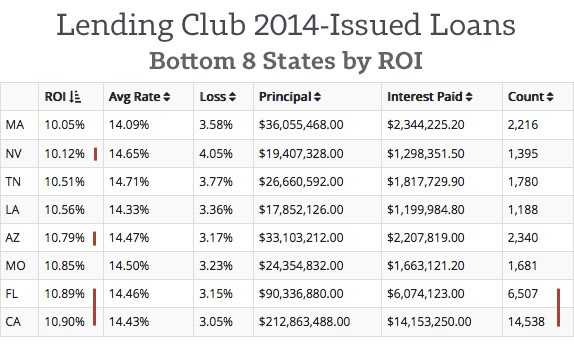
The last one, excluding small business loans, is potentially dead. The 2014 loan data does not really show any advantage we can gain by excluding business loans. In fact, they are some of the highest performing loans currently being issued:
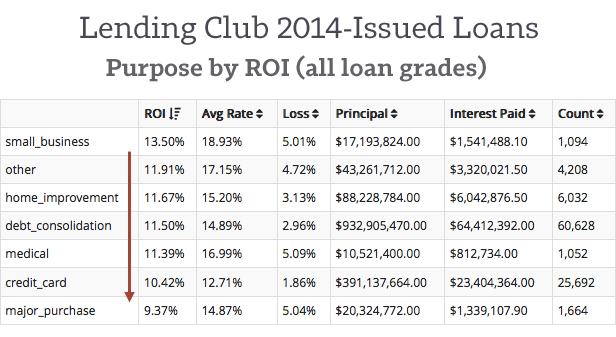
That said, the filter has been so effective in the past that I’m going to give it another quarter or two before removing it.
My Prosper filter (higher risk loans)
Prosper ratings: D, E, & HR
Goal: 10-11% ROI
See this filter on NSR
Filter criteria:
- Inquiries: 0
- Income: $25,000 or more
- Loan purpose: ‘Debt consolidation’ only
- States: Exclude CA & FL
Again, pretty simple and trustworthy, even for a yield-chaser like myself. The main focus is again on recent inquiries, in which Prosper offers an incredible 1.4% bump:

Filtering by stated income has become less powerful than it used to be. I’ve bumped the minimum down from $50,000 to $25,000, and you can see the filter is not completely consistent across different incomes:
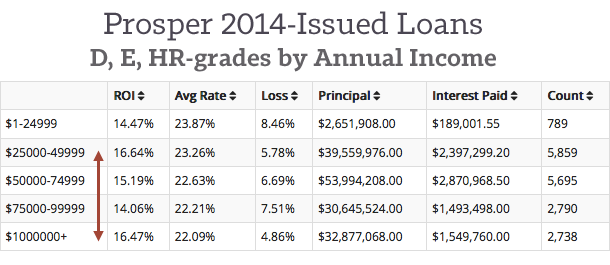
For my investment filters, a focus on debt consolidation is probably the only difference between Prosper and Lending Club filtering:
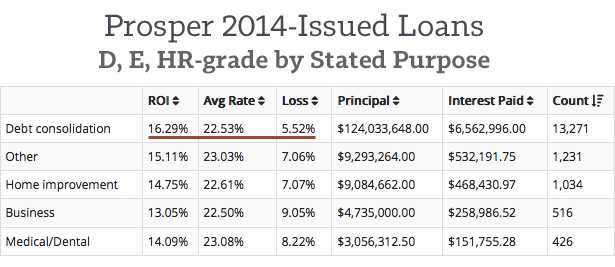
Finally, I continue to exclude CA and FL from Prosper. I won’t post the breakdown, but they continue to underperform at there as well.
Focus on the Simple and Powerful Filters
The beauty of filters like recent credit inquiries and annual income is that I’ve been using them since I began lending in 2011. While becoming less effective over time, they have remained strong options while other filters have stopped working. Some may feel a temptation to drill down into hyper-specific filters for a higher potential return, and this may sometimes work as a short term tactic. But in the end, most return back to the simpler approaches.
For example, here is a screenshot of all my saved filters at Prosper.com:
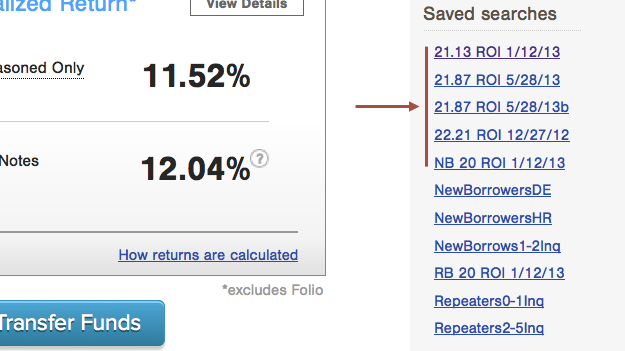
I don’t use these anymore since I invest offsite via API. However, they’re still saved and give me a picture for how things used to be. In short, the loan data was so young and the interest rates were so high that the tools were spitting out ROIs over 20%. Back then, investors could earn dramatically higher returns if they filtered by five to ten different criteria or more.
And while most of the ten filter criteria I used back then have lost their potency today, filtering by inquiries and income has generally remained strong.
How Should You Filter? Choose a Grade, Keep it Simple
Most investors probably need to filter very little. Step-by-step, here is what it might look like:
- Choose your risk tolerance (Read: “What Loan Grades Should I Choose?”)
- Credit inquiries = 0
- More income is better
That’s it. A decent idea is to adjust the minimum income filter for how many loans you need. So if you need to invest a large lump sum at a site like Lending Club, and “minimum income=$85,000” is not picking up enough loans, perhaps drop the minimum to $35,000. Once your available cash is gone, you can put it back to normal. Basically, you can make the filter less strict if it needs to fund a larger number of loans.
If you want to use some additional simple filters (like excluding CA/FL) go for it. At worst, you may simply hit the platform average and still earn a great return. At best, you’ll be in the top investors for your particular bracket.
If you want to go a step further, open up the NSR backtesting tool used throughout this article, set the minimum date to January 1st of this year, and start looking through the data for criteria that is performing better than average. For example, here are Lending Club’s 2014 loans broken down by home ownership, with obvious ROI to be gained from investing in people who have a mortgage:
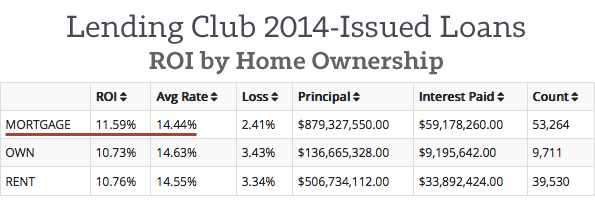
If you choose to invest through a self-constructed filter, make sure (1) it has one or two thousand historical loans so as to be statistically significant, and (2) that you check in with the backtesting tool each quarter to see how your criteria’s historical performance has adjusted, making changes accordingly.
Filtering can be one of the most enjoyable parts of peer to peer lending.
Filtering loans is quite often the most complicated part of peer to peer lending. You have to encounter unfamiliar terminology like ‘debt-to-income ratio’ and ‘public records’. However, I think filtering can be one of the most enjoyable parts of it as well. Finding little hidden pockets of higher ROI borrower attributes in the open data is akin to hunting treasure – you actually get money for being curious toward the data, taking time to understand it, and exploring its nooks and crannies for criteria with higher past performance.
Ultimately though, filtering is likely an element of peer to peer lending’s infancy. Really, it’s just an inefficiency that will eventually be gone. Just as the majority of the filters I used in 2012 no longer work, powerful ones like ‘credit inquiries=0’ are likely to stop working at some point as well. That said, today in October of 2014, filtering still exists as a great opportunity to increase our peer to peer lending returns.

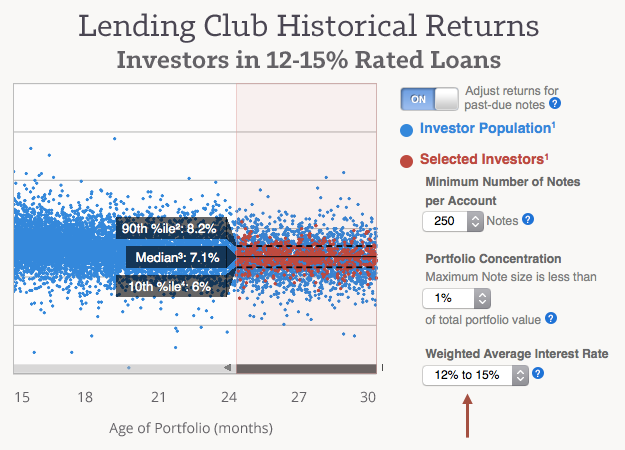
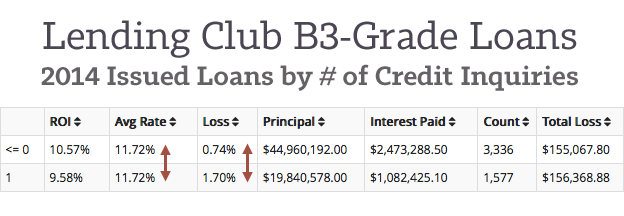
Thanks for sharing your filters.
I agree with you that finding a filter that works well is one of the most rewarding parts of P2P investing. It can be a little bit obsessive at times though, always trying to find a little improvement here and there. Good reminder to keep it simple for that very reason.
Plus the more complex the criteria the better chance you are overfitting and not really improving predictive quality. Methods for model selection usually penalize more parameters to some extent.
Thanks JJ. Are your filters similar in any way? Care to reveal a corner of your own criteria?
You really need to stop calling it peer to peer, the companies themselves no longer refer to it as P2P… that’s from the past just as filters will be in the coming years… Calling it P2P almost offends me anymore as any semblance to that has been driven out the door.
Hi Joe. Actually it is peer to peer lending. The larger “online lending” industry is now called that, or marketplace lending, but this site focuses on the smaller side to it that still is peer to peer, meaning, average Americans borrowing from and lending to average Americans. Retail investors may only represent a small cross-section of Lending Club’s investing dollars, but that is who this site is geared toward.
Hi Simon,
Just some feedback on your filters.
Limiting inquiries to 0 is really cutting out a lot of potentially stellar loans. Inquires remain on your credit file for 2 years. Things like signing up for a new phone contract or buying/leasing a car require a hard credit inquiry and are not necessarily bad nor indicative of people fishing for loans. From my own analysis, less than 2 is what you should be aiming for.
The most important aspect of your filter is that you are applying it across the board, which in my eyes is a mistake. A better approach would be to build filters specific to different FICO bands. For example, I’d make sure that borrowers with an average FICO score have a higher annual income as compared to borrowers with an excellent FICO score.
Lastly, and I have seen this cut out a majority of the charge offs / defaults in my historical analysis, is analyzing data that is hiding between the lines. What am I talking about? Applying a little math to the data. You’d be surprised how many people default because they have a high payment to income ratio.
Love the blog, looking forward to new content. Keep up the good work.
Hi and thanks for the comment. Both these companies only consider inquiries in the past six months. And I have used that filter specifically because it has generally worked across all credit bands.
Your comment about adding math to the equation is, of course, a much better approach than filtering, and is the subject of my next post.
database guy,
your comment on math is intriguing me. Prosper has a debt to income ratio as a filter…is that new since you posted perhaps?
I see that one could add the new loan being sought to the existing revolving balance, and make a decent assumption on the interest rate based on the fico credit band, and come up with a monthly payment, and compare that to the low end of the stated income range.
The flaw i see is the borrowers may have other debts that arent revolving (ie mortgage) and so I dont know how to get a complete debt picture without making assumptions about those – which is tricky as there is no further data.
given that, isnt the debt to income ratio a good proxy to use vs doing math on payments vs income?
thanks
How do you analyze LC data? I use NSR for my own Extended Notes cvs file but NSR doesn’t seem to be able to process the cvs file for lending club stats (https://www.lendingclub.com/info/download-data.action). Do you use NSR or some other platform?
Rachael
Have you noticed an increase in defaults/late for the state of TX? I’m seeing it on my Prosper account and it may be a precursor to larger defaults for TX due to energy sector issues.
Your goal ROI for lending club is 10-11 percent but i don’t see where you can specify that on their website or is that just a goal?
The ROI figure not a filter setting, it’s a result of the filter in the NSR tool.
Simon, how are these filters working for you in mid-2017?